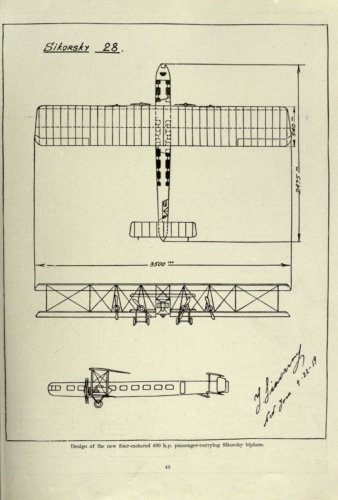- Joined
- 25 June 2009
- Messages
- 14,108
- Reaction score
- 4,239
After spending several months in France working on the so-called Avion Atlas night bomber for the French government, Igor Ivanovich Sikorsky arrived in the United States early in April 1919, with letters of introduction from both the French Goverment and the chief of American air operations in France. Days later, he declared to the New York Times: "My decision to manufacture my planes in the United States was the result of a belief that this country offers a great future for aviation." He was interested in "the opening up of air routes throughout the country" admitting that he had already discussed a number of them with American promoters, including a possible New York-Chicago line.
For that purpose, Sikorsky expected "to place on the market a passenger-carrying plane that should appeal to companies formed for aerial transportation." That was the "Sikorsky 28", the first design he meant for the American market. It was an adaptation of the battleplane designs which had been used extensively in heavy bombing during World War I, and was practically the same as the Avion Atlas (designated I.S.27) designed for France in 1918.
Intended primarily for passenger traffic, the "28" was designed to carry thirty-two passengers plus a crew of six. However, with slight modifications it could be used for freight carrying. It was to be powered by four 400 hp engines, capable of maintaining an average speed of ninety miles per hour. Although there were two engines on either side of the pilot, the aircraft could be flown with only two engines working at the same time.
The "28" was designed for safety as well as comfort, with the passengers sitting in an enclosed body somewhat resembling a Pullman car. Unique features were an observation windows and especially a glass floor, which enabled the passengers to watch the country go by underneath them. Provision was also made for a kitchen, a luggage room, a mail compartment and a lavatory. The cabin was to be lit by an electric system, and the heating to be provided by the exhaust gases of the engines.
Most unusual was the idea of providing a promenade deck on the lower wings "for the use of the more adventurous passengers," a feature which Sikorsky had experimented with successfully on several of his Russian airplanes. There were two versions of the "Sikorsky 28":
Adapted from Russian Airplanes Will Be Made Here, The New York Times, 20 April 1919
For that purpose, Sikorsky expected "to place on the market a passenger-carrying plane that should appeal to companies formed for aerial transportation." That was the "Sikorsky 28", the first design he meant for the American market. It was an adaptation of the battleplane designs which had been used extensively in heavy bombing during World War I, and was practically the same as the Avion Atlas (designated I.S.27) designed for France in 1918.
Intended primarily for passenger traffic, the "28" was designed to carry thirty-two passengers plus a crew of six. However, with slight modifications it could be used for freight carrying. It was to be powered by four 400 hp engines, capable of maintaining an average speed of ninety miles per hour. Although there were two engines on either side of the pilot, the aircraft could be flown with only two engines working at the same time.
The "28" was designed for safety as well as comfort, with the passengers sitting in an enclosed body somewhat resembling a Pullman car. Unique features were an observation windows and especially a glass floor, which enabled the passengers to watch the country go by underneath them. Provision was also made for a kitchen, a luggage room, a mail compartment and a lavatory. The cabin was to be lit by an electric system, and the heating to be provided by the exhaust gases of the engines.
Most unusual was the idea of providing a promenade deck on the lower wings "for the use of the more adventurous passengers," a feature which Sikorsky had experimented with successfully on several of his Russian airplanes. There were two versions of the "Sikorsky 28":
- Option "A": two engines placed on the lower wing, the third in the nose or the back of the nacelle fuselage.
- Option "B": two engines placed on the lower wing, third on the upper wing, tailplane had a different form of fastening.
Adapted from Russian Airplanes Will Be Made Here, The New York Times, 20 April 1919

